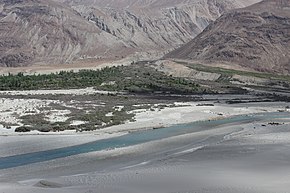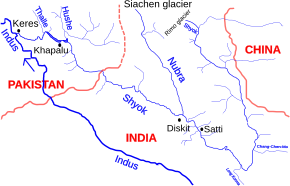Nubra River
| Nubra River Yarma Tsangpo | |
|---|---|
 Nubra River | |
 Nubra/ Shyok watershed | |
| Location | |
| Country | India |
| Union Territory | Ladakh |
| Region | Ladakh |
| District | Leh |
| Physical characteristics | |
| Source | 35°4′N 77°1′E / 35.067°N 77.017°E |
| • location | Siachen Glacier |
| • elevation | 5,753 m (18,875 ft) |
Shyok river at Khalsar | |
| Length | 80 km (50 mi) |
| Basin features | |
| River system | Indus River |
The Nubra River is a
Geography
The
The side valleys of the Nubra Valley contains some 33 glaciers of varying proportions, and the heavy sediment load carried by the river from the melt-water is responsible for many
Siachen Conflict
The river was rafted by an Indo-German team in 1978[12] under the leadership of Narendra Kumar.[13] Certain features in the maps used by the Germans led to India's understanding of cartographic aggression by Pakistan and a subsequent mountaineering reconnaissance expedition of the region was planned; which in turn led to Operation Meghdoot.[13][14]
Ecological crisis
The Siachen Glacier, the source of the Nubra River, has for some time[nb 1] been the scene of conflict between India and Pakistan, and has been called the world's highest battleground.[16] The 20,000 troops stationed on the glacier produce a lot of waste,[nb 2] 40% of which is plastic and metal. This debris, including irreparable vehicles, war debris, parachute material, canisters, clothing, and human waste, is simply tipped into crevasses in the glacier. With no natural biodegradation taking place, the ice is being permanently contaminated by toxins such as cobalt, cadmium, and chromium. The washing of warfare clothes at hot sulfur springs near the Indian base camp also contaminates the river. The toxins will eventually reach the Indus River, with millions of downstream users potentially being impacted.[17][18][19]
Tourism
There are
See also
Notes
- ^ The conflict began in 1984 with India's successful Operation Meghdoot during which it gained control over all of the Siachen Glacier (unoccupied and undemarcated area). India has established control over all of the 70-kilometre-long (43 mi) Siachen Glacier and all of its tributary glaciers, as well as all the main passes and heights of the Saltoro Ridge immediately west of the glacier, including Sia La, Bilafond La, and Gyong La. Pakistan controls the glacial valleys immediately west of the Saltoro Ridge.[15]
- ^ The 20,000 troops stationed on the Siachen are supplied (flown and parachuted) thousands of tons of food and supplies every year. Indian army officials have described the Siachen as "the world’s biggest and highest garbage dump", from where nothing comes back. World Commission on Protected Areas estimates that over 2000 lbs. of human waste are dropped daily into crevasses of the glacier.[17]
References
- ^ "Siachen Glacier | glacier, Karakoram Range, Asia". Encyclopedia Britannica. Retrieved 5 February 2019.
- ^ "Longest non polar glaciers in the world". Worldatlas. Retrieved 13 May 2019.
- Fedchenko Glacieris 77 km (48 mi) long. The second-longest in the Karakoram Mountains is the Biafo Glacier at 63 km (39 mi). Measurements are from recent imagery, supplemented with Russian 1:200,000 scale topographic mapping as well as the 1990 "Orographic Sketch Map: Karakoram: Sheet 2", Swiss Foundation for Alpine Research, Zurich.
- ^ "LOTS IN A NAME : Himalayan Journal vol.48/18". www.himalayanclub.org. Retrieved 16 March 2019.
- ^ ISBN 9789401780292.
- ISBN 9788170623014.
- ^ ISBN 9788170623014.
- ISBN 0-540-05831-9.
- ISBN 9789401780292.
- ISBN 978-81-85182-61-2.
- ^ Drew, Frederic (1875). The Jummoo and Kashmir Territories: A Geographical Account. E. Stanford. pp. 273–280.
- ISBN 9789385563560.
- ^ ISBN 9789384052263.
- ^ Bhattacharya, Suryatapa (19 June 2012). "War on the roof of the world still chills, decades on". The National. Retrieved 2 February 2020.
- ISBN 9780312060671.
- ^ "Blog: A 60-km Trek to the World's Highest Battlefield, Siachen". NDTV.com. Retrieved 5 February 2019.
- ^ a b "Stanford Environmental Law Journal" (PDF). uvm.edu. Retrieved 20 February 2019.
- ^ Kemkar, Neal A. (2006). "Environmental Peacemaking: Ending Conflict between India and Pakistan on the Siachen Glacier through the Creation of a Transboundary Peace Park" (PDF). Stanford Environmental Law Journal. 67: 81, 82.
- ^ Bedi, Jatinder Singh (29 August 1998). "The Tribune 'Save the Himalayas' campaign — VI---World's highest, biggest junkyard". www.tribuneindia.com. Retrieved 16 March 2019.
- ^ Places to see in the Nubra Valley, traveltriangle, accessed 27 July 2023.
